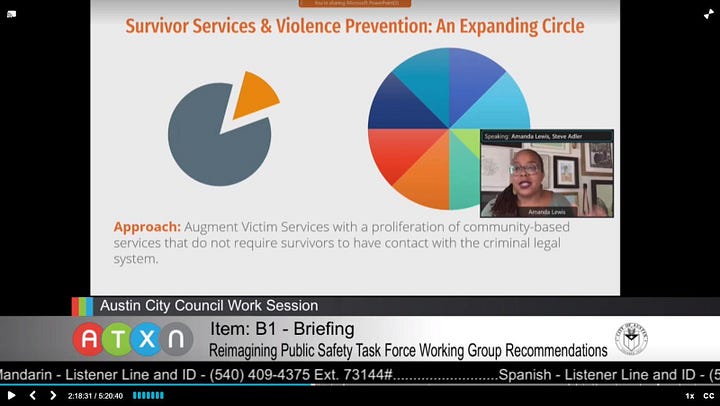Austin, Texas, USA
A Data-Driven Mindset Helps Austin Reimagine Public Safety.
Project Type:
Community Engagement, Equity, Finance, High-Performing Government, Public Safety
At a Glance
The City’s five-year plan includes data-driven performance management to track how Austin accomplishes their goals such as safety, budget resources, and community services.
Formed a Reimagining Public Safety Task Force to offer recommendations to improve the Austin Police Department and public safety services.
Austin’s strategic performance dashboard allows the public to keep tabs on progress toward all six of SD23’s strategic outcomes: economic opportunity and affordability; mobility, safety, health and environment; culture and lifelong learning; and government that works for all.
Reimagining Public Safety
In May 2020, residents of Austin, Texas took to the streets to protest the deaths of George Floyd, a Black man from Minneapolis, and Michael Ramos, a Black and Latinx man from Austin, at the hands of police officers.
Soon after, the City took action to rethink public safety and increase racial equity. In June, the City Council passed a resolution to achieve major new benchmarks: zero racial disparities in traffic stops, zero racial disparities in citations and arrests from traffic stops, and zero deaths at the hands of Austin police officers.
The same month, the City formed a Reimagining Public Safety Task Force made up of both city government and community group members. Its charge: offer recommendations to City Council for policy, budget, and structural changes to be made to the Austin Police Department (APD) and public safety services.
Data to Guide Public Safety Outcomes
The City wasn’t starting from scratch, however. The underpinnings of Austin’s public safety overhaul are driven by Strategic Direction 2023 (SD23), a five-year plan adopted by City Council in 2018 that has infused data-driven performance management into how Austin achieves ambitious goals. One of the plan’s targeted strategic outcomes is safety, and a key performance indicator (KPI) supporting that goal is “fair administration of justice.” Data gathering and analysis has guided the City’s work in this area, laying the groundwork for reform decisions.
For example, Austin’s Office of Police Oversight, Office of Innovation, and Equity Office jointly analyzed APD’s racial profiling data. Their joint report will serve as a baseline for future annual analyses. It found that in 2019, Black people made up 14 percent of all motor vehicle stops, 25 percent of all stops resulting in searches, and 25 percent of all stops resulting in arrests, though they comprise just 8 percent of the City’s population. The City has also analyzed 911 call data, finding that 41 percent of police officer time is spent on “Priority 3” calls — meaning that life or property is not at risk — and that 10 percent of all calls were related to mental health in some way.
The data raised some basic questions for the task force. “What do we want law enforcement to do, and what do we not want them to do?” says Farah Muscadin, director of the Office of Police Oversight and a member of the task force. “And how can we align ‘protecting and serving’ with what they’re actually trained to do?” Solutions needed to be informed by data — including qualitative data gathered from “community members disproportionately impacted by law enforcement,” she says. “We wanted them to help us come up with solutions so that everybody feels safe.”

To engage community stakeholders and gather qualitative data that would inform the task force’s work, each of Austin’s 10 Council Districts held a public listening session. There were also three citywide sessions, including one held in Spanish. The events included scenario-based conversations with residents about how they thought the City should handle certain public safety situations. To ensure the voices of those disproportionately impacted by inequities in public safety services were heard, a diverse range of community organizations and neighborhood associations hosted more than two dozen sessions in addition to the city-hosted events.
A total of nearly 1,000 people participated across a range of ZIP codes, races and ethnic groups, and the takeaway was clear. “In most of the scenarios, the majority of folks said that they didn’t want a police response,” says Brion Oaks, the city’s first-ever Chief Equity Officer, who co-chairs the task force. “But the reality is that today, it’s the only response we offer.”
In April 2021, the task force issued its recommendations report, focusing on various ways the City Council could reallocate funds away from APD to bolster the safety and wellbeing of communities of color. Recommendations included defunding the mounted patrol and K-9 units of the APD, and creating a center to respond to mental health calls separate from the 911 police dispatch system. The report offers a data-informed reimagining of the City’s public safety budget, building on City Council’s decision last year to redirect $153 million of APD’s budget.

Since then, the Governor of Texas signed HB 1900. The legislation creates severe financial penalties for any city that meets the definition of a “defunding municipality.” Austin’s proposed Fiscal Year 2022 budget fully complies with the new law, but the City remains committed to advancing progress on reimagining public safety initiatives.
“Let’s think big. What if we really wanted to make our city safer? Are we willing to engage in the re-imagining of policing if it could make us safer?”
Becoming a Data-Driven Organization
The City’s work to address racial inequities and increase police accountability can’t be separated from the data-driven performance framework established through SD23, says Kimberly Olivares, Austin’s deputy chief financial officer and former chief performance officer. The public safety work is just one dimension of the framework, which the entire city government is now geared toward.
“Our city manager has restructured his leadership team and the budget process around the strategic outcomes within the plan. It’s become part of our everyday life and how we talk about what we do and how we serve the community.”
The City maintains a strategic performance dashboard, allowing the public to keep tabs on progress toward all six of SD23’s strategic outcomes: economic opportunity and affordability; mobility; safety; health and environment; culture and lifelong learning; and government that works for all. The dashboard breaks each goal down into different indicator categories and metrics measuring progress, each given a clear status: “on track,” “off track,” “near target” or “measuring.” The City, in other words, is holding itself publicly accountable for SD23’s goals. (The dashboard is just one component of Austin’s larger open data portal.)

Having clear, shared priorities and KPIs to rally around was a crucial first step in the City’s performance management journey — and there was a strong desire across city departments for SD23’s structured approach, says Spencer Cronk, Austin’s city manager. The next step: establishing data-driven governance practices that enable change to be defined and tracked.
“You have to measure and make visible what you want to change and how you want to change,” Cronk says. “Defining success through specific data indicators has helped us stay focused — and that’s helping us achieve real outcomes for our residents.”